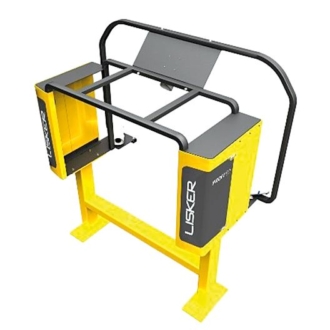The scanning techniques have developed with huge steps during the past years. Today digital log scanners are able to scan several hundred scans/s. In 1990’s, the typical analog cameras of the era were only able to scan 60 scans/s. Today, the cross sections of the log are scanned typically after every 1–2cm.

© Lisker Oy
Log scanning for rotation
In the beginning of the sawing line logs are scanned before the log rotation mechanics. Typical values to scan and report are top diameter, length, volume, sweep, ovality and taper. Scanner creates an accurate 3D-model of the log.
The benefits of log 3D-model are:
- Polar coordination representation of the log includes individual radius value after every degree round the cross section.
- This point cloud can be used to calculate log center line and be utilized in active curve sawing of the log, where log is curve sawed up to a certain predefined radius.
- The predefined radius limits the curve sawing if logs have a bigger sweep than the radius in question.
- It is good to keep in mind that straight logs will produce straight cants and squares after reducers.
Control of automatic log rotation
Log rotation is primarily controlled based on log sweep, ovality and volume optimized yield.
1. Sweep Sweep is the main factor of log rotation on sawing lines, which have curve sawing capability. Best yield is achieved by following the main sweep of the log with active curve sawing. The mechanical solutions of the sawing line determine, whether the sweep is rotated up, down or sideways.
Log sweep is typically rotated into such position, that secondary breakdown sawn timber faces have the remaining sweep after curve sawing. It is allowed to have a certain degree of sweep in the sawn timber faces, but not that much on the edges.
2. Ovality Relatively straight logs can be rotated based on ovality, so that ovality’s main diameter is rotated according to the main diameter of the sawing pattern. By doing this, the length of sawn timber pieces is maximized in the most restricting position, the top of the log.
3. Volume yield Log rotation based on volume optimization yield chooses the best rotation angle according to maximum sawn timber yield. The sawing line mechanics has to be modelled to the scanner to be able to calculate accurately the opened faces of cant or square after each sawing phase, which form the basis for optimization. Also, the line’s ability to skew side boards must be addressed in the optimization.

